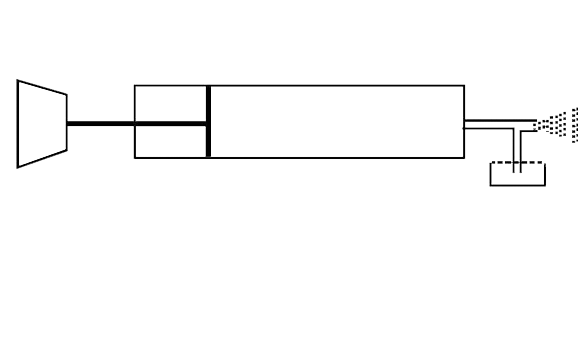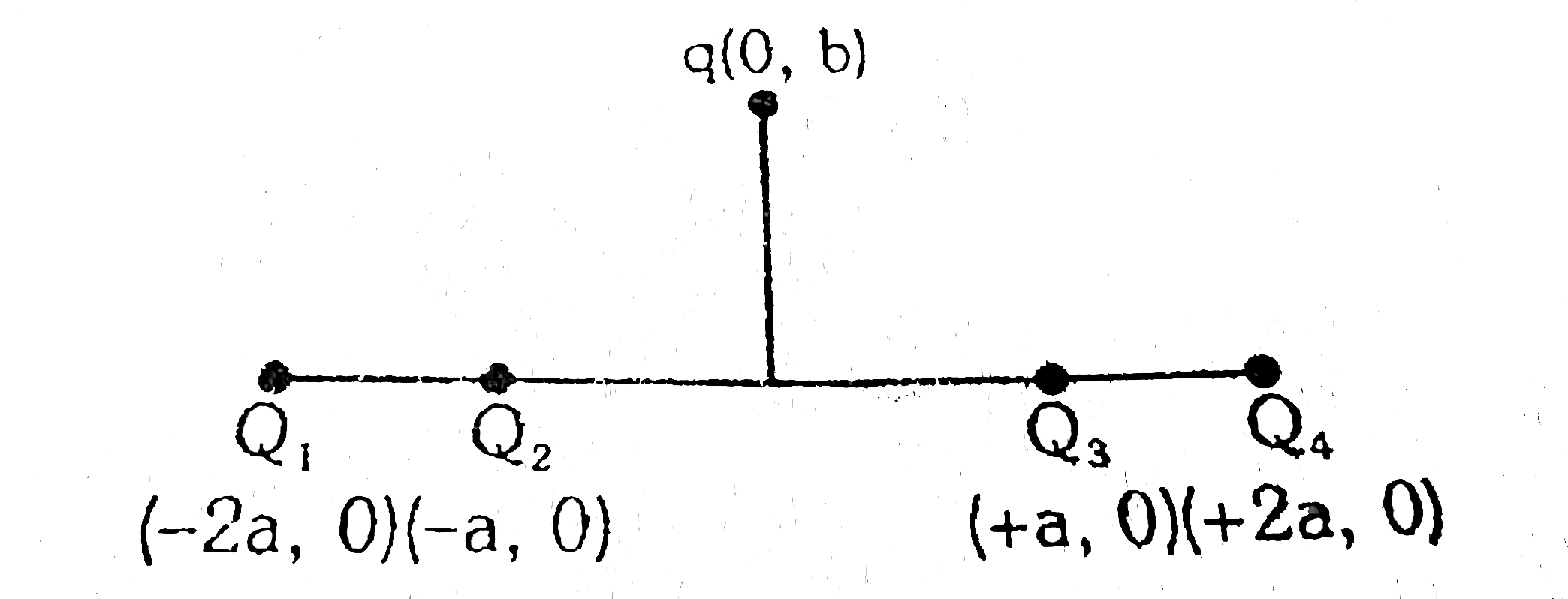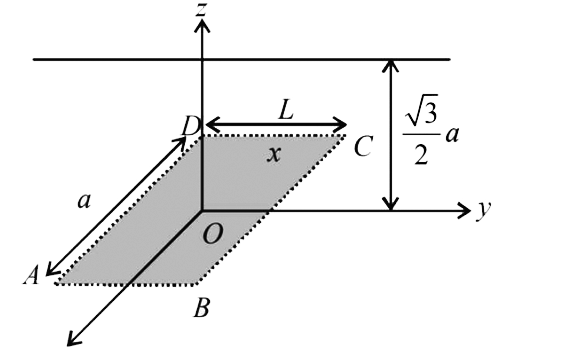A spray gun is shown in the figure where a piston pushes air out of a nozzle. A thin tube of uniform cross section is connected to the nozzle. The other end of the tube is in a small liquid container. As the piston pushes air through the nozzle, the liquid from the container rises into the nozzle and is sprayed out. For the spray gun shown, the radii of the piston and the nozzle are 20mm and 1mm respectively. The upper end of the container is open to the atmosphere.

If the piston is pushed at a speed of 5mms−1, the air comes out of the nozzle with a speed of
0.1ms−1
1ms−1
2ms−1
8ms−1
The correct Answer is:C
Step by step video & image solution for A spray gun is shown in the figure where a piston pushes air out of a nozzle. A thin tube of uniform cross section is connected to the nozzle. The other end of the tube is in a small liquid container. As the piston pushes air through the nozzle, the liquid from the container rises into the nozzle and is sprayed out. For the spray gun shown, the radii of the piston and the nozzle are 20mm and 1mm respectively. The upper end of the container is open to the atmosphere. If the piston is pushed at a speed of 5mms^-1, the air comes out of the nozzle with a speed of by Physics experts to help you in doubts & scoring excellent marks in Class 12 exams.
Topper's Solved these Questions
- BOOK - JEE ADVANCED PREVIOUS YEARCHAPTER - JEE ADVANCEDEXERCISE - SECTION -3 (MATCHING LIST TYPE)3videos
JEE ADVANCED
- BOOK - JEE ADVANCED PREVIOUS YEARCHAPTER - JEE ADVANCEDEXERCISE - Section-18videos
JEE ADVANCED
- BOOK - JEE ADVANCED PREVIOUS YEARCHAPTER - JEE ADVANCEDEXERCISE - SECTION - 1 (ONLY ONE OPTION CORRRECT TYPE)10videos
JEE ADVANCED
- BOOK - JEE ADVANCED PREVIOUS YEARCHAPTER - JEE (ADVANCE) 2020EXERCISE - SECTION 36videos
JEE (ADVANCE) 2020
- BOOK - JEE ADVANCED PREVIOUS YEARCHAPTER - JEE ADVANCED 2020EXERCISE - SECTION-36videos
JEE ADVANCED 2020
Similar Questions
Four charges Q1,Q2,Q3 and Q4 of same magnitude are fixed along the x axis at x=−2a,−a,+a and +2a, respectively. A positive charge q is placed on the positive y axis at a distance b>0. Four options of the signs of these charges are given in List I. The direction of the forces on the charge q is given in List II. Match List I with List II and select the correct answer using the code given below the lists.

List-IList-II(P)Q1,Q2,Q3,Q4all positive(1)+x(Q)Q1,Q2 positive, Q3,Q4 negative(2)−x(R)Q1,Q4 positive ,Q2,Q3 negative(3)+y(S)Q1,Q3 positive , Q2,Q4 negative(4)−y02:34View SolutionAn infinity long uniform line charge distribution of charge per unit length λ lies parallel to the y-axis in the y−z plane at z=√32 a(see figure). If the magnitude of the flux of the electric field through the rectangular surface ABCD lying in the x−y plane with its centre at the origin is λL≠ψlon0 (ε0= permittivity of free space), then the value of n is
 06:44View Solution
06:44View SolutionA tennis ball dropped on a barizoontal smooth surface , it because back to its original postion after hiting the surface the force on the bell during the collision is propertional to the length of compression of the bell . Which one of the following skethes desches discribe the variation of its kinetic energy K with time 1 mass apporiandly ? The figure as only illistrative and not to the scale .
06:44View SolutionA spherical bubbles inside water has radius R . Take the pressuere in the bubbled and the water pressure to be pv. The bubble now gets compressed radially in an adiabatic manner so that its raduis becomes (R - a) . For a<<R the magnitude of the work done in the process is given by (4πpoRa2)X. where X is a a constant and y=Cp/Cv=41/30. The value of X is
03:39View SolutionPut a unifrom meter scale horizontally on your extended index fingers with the left one at 0.0 cm and the right one at 90.00 cm when you attempt to move both the fingers slowly towards the center , initially only the left finger slips with respect to to the scale and the right finger does not . after some distance, the left finger stops and the right one starts slipping . Then the right finger stops at a distance XR from the center (50.00 cm ) of the scale and the left one starts slopping again . This happens because to the difference in the fiictional forces on the two fingers . it the coefficients of static and dynamic between the fingers and the scale are 0.4 and 0.32 respectively , the value of XR (in cm is ...........
04:15View SolutionFigure shows a liquid being pushed out of a tube by pressing a piston. The area of cross section of the piston is 1.0 cm^2 and that of the tube at the outlet is 20mm2. If the piston is pushed at a speed of 2cms−1. What is the speed of the outgoing liquid?
 03:50View Solution
03:50View SolutionA spray gun is shown in the figure where a piston pushes air out of a nozzle. A thin tube of uniform cross section is connected to the nozzle. The other end of the tube is in a small liquid container. As the piston pushes air through the nozzle, the liquid from the container rises into the nozzle and is sprayed out. For the spray gun shown, the radii of the piston and the nozzle are 20mm and 1mm respectively. The upper end of the container is open to the atmosphere. If the piston is pushed at a speed of 5mms^-1 , the air comes out of the nozzle with a speed of
View SolutionA spray gun is shown in the figure where a piston pushes air out of a nozzle. A thin tube of uniform cross section is connected to the nozzle. The other end of the tube is in a small liquid container. As the piston pushes air through the nozzle, the liquid from the container rises into the nozzle and is sprayed out. For the spray gun shown, the radii of the piston and the nozzle are 20mm and 1mm respectively. The upper end of the container is open to the atmosphere.

If the density of air is ρa, and that of the liquid ρl, then for a given piston speed the rate (volume per unit time) at which the liquid is sprayed will be proportional to02:36View Solution_E01_216_Q01.png)
A syringe containing water is held horizontally with its nozzle at a height h above the ground as shown in fig the cross sectional areas of the piston and the nozzle are A and a respectively the piston is pushed with a constant speed v. Find the horizontal range R of the stream of water on the ground.03:42View Solutionचित्र में दिखाई गई पिचकारी में एक पिस्टन वायु को एक चंचू (nozzle) द्वारा बाहर धकेलता है। चंचू के सामने एकसमान अनुप्रस्थ काट वाली पतली नली लगी है। नली का दूसरा सिरा द्रव से भरे एक छोटे पात्र में है। जब पिस्टन वायु को चंचू से बाहर धकेलता है, तब पात्र में द्रव उठकर चंचू में आ जाता है और फुहार के रूप में बाहर निकलता है। चित्र में दिखाई गई पिचकारी में पिस्टन तथा चंचु की त्रिज्याएँ क्रमशः 20mm तथा 1mm है। पात्र का ऊपरी भाग वातावरण में खुला है।

पिस्टन को 5mms−1 की गति से धकेलने पर चंचू से बाहर वाली वायु की गति है-02:47View Solutionचित्र में दिखाई गई पिचकारी में एक पिस्टन वायु को एक चंचू (nozzle) द्वारा बाहर धकेलता है। चंचू के सामने एकसमान अनुप्रस्थ काट वाली पतली नली लगी है। नली का दूसरा सिरा द्रव से भरे एक छोटे पात्र में है। जब पिस्टन वायु को चंचू से बाहर धकेलता है, तब पात्र में द्रव उठकर चंचू में आ जाता है और फुहार के रूप में बाहर निकलता है। चित्र में दिखाई गई पिचकारी में पिस्टन तथा चंचु की त्रिज्याएँ क्रमशः 20mm तथा 1mm है। पात्र का ऊपरी भाग वातावरण में खुला है।

यदि वायु का घनत्व ρaहै और तरल का ρl तब दी गई पिस्टन गति के लिए दर (मात्रा प्रति इकाई समय) जब वह तरल का छिड़काव किया जाता है तो वह आनुपातिक होगा:03:27View SolutionA syring containing water is held horizontally with its nozzle at a height, h = 1.25 m above the ground as shown in Fig. 3.42. The diameter of the piston is 5 times that of the nozzle. The is pushed with a constant speed of 20 cm. s^-1. If g= 10m . s^-2 .
05:22View SolutionCatch prey with the help of tube fit or nozzles -
04:52View Solutionपानी से भरी हुई एक सीरिंज को क्षैतिज रखा गया है, इसकी नोजल चित्र में दर्शाये अनुसार जमीन से h ऊँचाई पर है। पिस्टन एवं नोजल के अनुप्रस्थ काट क्षेत्रफल क्रमश: A एवं a है। पिस्टन स्थिर गति v से दबाया जाता है। जमीन पर पानी की धार की क्षैतिज परास ज्ञात कीजिये।
 01:43View Solution
01:43View SolutionFigure shows a liquid being pushed out of a tube by pressing a piston. The area of cross section of the piston is 1.0 cm^2 and that of the tube at the outlet is 20mm2. If the piston is pushed at a speed of 2cms−1. What is the speed of the outgoing liquid?
 04:42View Solution
04:42View SolutionA piston of cross sectional area 2cm2 pushes the liquid out of a tube whose area at the outlet is 40mm2. The piston is pushed at a rate of 2cm/s. Determine the speed at which the fluid leaves the tube.
03:57View Solution

